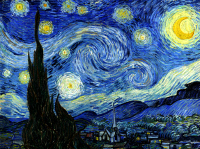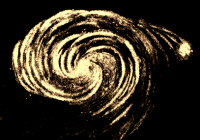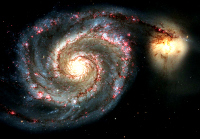 |  | | About the 'poetic licence' Adaptations of "Starry Night" (Van Gogh, 1889)
 & & 
NASA's "Astro-Pic of the Day" (3mar2017)
1. Van Gogh (1853-1890) painted " Starry Night" in June 1889, a few weeks before a second mental breakdown in the St. Rémy asylum in Provence & a year before his death. While some art critics have seen profound otherworldly or religious symbols & even proof of insanity in this painting, at least two have, to my delight, made reference to astronomical phenomena. Apart from the fact that anyone can see the Milky Way among the planets and constellations in the night's sky, Van Gogh could have been further informed by popular illustrations, such as depicted in L'astronomie populaire published in 1879 by Camille Flammarion (1842-1925). One drawing there is an 1845 depiction of the Whirlpool "Nebula" by astronomer Lord Rosse (William Parsons, 1800-1867). This distant spiral object beyond the constellation Cassiopeia was first observed in 1773 by Charles Messier (1730-1817). -- Until 1923, it was believed that the Milky Way filled the entire Universe. Then Edward Hubble confirmed, that most of those gassy "clouds" previously described were in fact galaxies in their own right. -- Rosse's 1845 sketch (1.a.) bears a remarkable resemblance to both the central swirls in Van Gogh's 1889 painting (1.), and to NASA's photograph of the Whirlpool galaxy ("M51" / 1.b.), which is 31 million light-years away.* It was taken in January 2005 with the Hubble Space Telescope (this site also has an impressive video of M51 ; 45 sec/8mb) *Reminder: 1 light-year = ca. 6 TRILLION miles! That is a "1" with either 12 (Am.) or 18 zeros (Brit.)
2. NASA's "Astronomy Picture of the Day" (3mar2017) was posted with the prosaic title " Sivan 2 to M31." It is a composite picture of the northern sky, showing "the relatively unknown nebula Sivan 2" on the left, the characteristic (if somewhat distorted) "W" shape of the Cassiopeia constellation in the middle, & our neighboring galaxy Andromeda (M31) on the right. Pieced together from twenty-four telescopic panels, it is part of the MDW Sky Survey, a mapping project that successfully endeavors to produce images that are "scientifically useful and aesthetically beautiful – a true blend of science and art." In light of the title, "art" here must be understood in a strictly visual sense. Compare it with NASA's April 2005 post above (1.b.), which bears the far more evocatively descriptive title "M51: Cosmic Whirlpool." -- The June 1889 "Starry Night" was not Van Gogh's only painting with a prominently featured celestial object: shortly before he was joinedin Arles by Paul Gauguin (1848-1903) in October 1888, he painted " Starry Night on the Rhône" (Sep. 1888; 3.a.). The seven stars of the Big Dipper in the northern constellation Ursa Major (3.b.) clearly dominate the sky scene. -- When Gauguin decided to leave Arles again in late December 1888, Van Gogh allegedly first assaulted him with a razor, then mutilated himself by cutting off his left ear. By May 1889, he voluntarily checked himself into the insane asylum in nearby St. Rémy. There he remained until May 1890, & produced some of his most acclaimed canvasses, including "our" "Starry Night" (1. above). For Van Gogh's Arles & St. Rémy periods, see WGA's "Various paintings ( Arles, September 1888 - April 1889)" &"Paintings in the asylum ... ( Saint-Rémy, May 1889 - May 1890)."
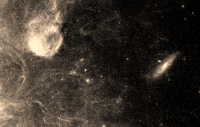 | 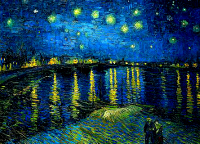 | 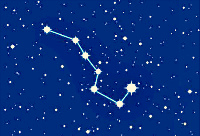 | 2. Starry Skies (r: M31)
NASA's Astro Pic, 3mar2017 | 3.a. Starry Night on the Rhône
(Arles, 1888) Musée d'Orsay, Paris | |
It is also worth noting for my two "Starry Nights" / "Starry Skies" renderings, that among the many scientific works of Van Gogh's contemporary Flammarion was an 1877 Atlas céleste and an 1879 star catalogue. The latter included most of Messier's famous Catalogue des Nébuleuses et des Amas d'Étoiles (1774 ff), of which Flammarion owned a rare annotated manuscript copy. All modern lists still include the "M" designations for Messiers' 106 sky objects described there. For instance, shown above are "M31" / Andromeda (in 2,, on the right), and "M51" / Whirlpool Galaxy (in 1.a. & 1.b.). -- Coming full circle: amateur stargazers can find M51 -- corresponding to the central swirls in Van Gogh's June 1889 "Starry Night" (1.) -- by following the Big Dipper's handle -- present his 1888 Rhône painting (3.a.). For precise instructions, see the description by the Hubble Heritage Team in NASA's 28.4.2005 Astro-Pic "M51: Cosmic Whirlpool."
Note, Bibliographical & General:
Just about the only tweets I follow with great interest are NASA's great series of images called "Astronomy Picture of the Day." When I saw the one posted there on Friday, March 3, 2017, I was reminded of Van Gogh's painting "Starry Night", & decided to adapt both stunning images*** for an inaugural webpage of a series to be called "gd's NASArt."
As always, I have drawn on the popular free internet resources wikimedia, wikipedia, the NASA "Picture of the Day"Archive, & the great Web Gallery of Art (WGA). -- Special thanks to the enthusiastic SEDS people for their impressive work on - among many, many others - Flammarion & Messier. For the latter's entire annotated Catalog of Nebulae and Star Clusters SEDS's Hartmut Frommert & his collaborators must be duly praised. *A couple of days ago, while looking for information on spiral galaxies, 1 came across the following late January2015 coverage by Public Radio International (PRI): "Was Van Gogh's 'Starry Night' inspired by a scientific drawing?" In an interview with Studio 360 about his 2014 book Csmigraphics: Picturing Space Through Time (NY, Abrams, 320 p.), author Charles Benson not only addresses a likely connection between the Painting & Rosse's sketch, but also covers the Nebra Sky Disk in great detail - the Image of which is credited to wikimedia & the University of Michigan Library. -- In June 2016, I put up a webpage about the Nebra Himmelsscheibe. It is based on information harvested from the Halle Landesmuseum für Vorgeschichte. How is this for a confluence of themes?
gd, Wed 15mar2017
A Disclaimer & a Dedication:
This inspirational venture has none other but a purely playful purpose. It iis by no means attempting to do justice to the truly grand originals.***
My "Erstling / Firstling"*is dedicated to my friends Hans & Kathi Braun of Trier
* (Those who know me will recognize a sly reference to a poem by the dadaist Else von Freytag-Loringhoven, 1874-1927)
| gd 5mar2017 |  |  |
Dr. Gaby Divay
Senior Scholar, Archives & Special Collections
208A Bldg Dafoe - University of Manitoba
Winnipeg, MB R3T 2N2
gd's UM HOME & UMArchives' FPG + FrL Websites
Phone: (204) 832 2179 ; divay@cc.umanitoba.ca |
|
